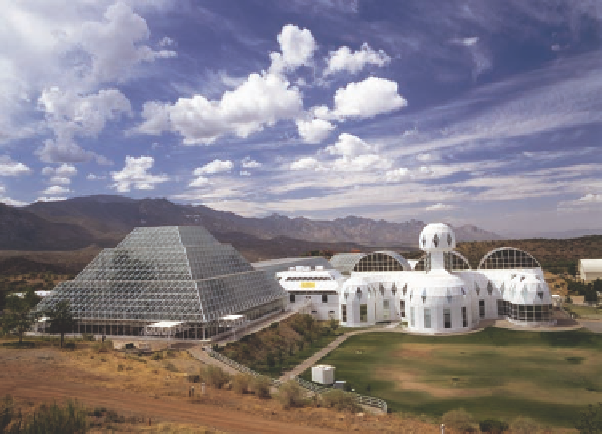Environmental Engineering Reference
In-Depth Information
18
Environmental Economics,
Politics, and Worldviews
CASE STUDY
Biosphere 2: A Lesson
in Humility
again. Human and animal excrement and other
wastes were treated and recycled to help support
plant growth.
The facility was stocked with more than 4,000
species of organisms selected to maintain life-support
functions. Sunlight and external natural gas-powered
generators provided energy. The Biospherians were
supposed to be isolated for 2 years and to raise their
own food using intensive organic agriculture, breathe
air recirculated by plants, and drink water cleansed by
natural recycling processes.
From the beginning, many unexpected problems
cropped up. The life-support system began unravel-
ing. Large amounts of oxygen disappeared when soil
organisms converted it to carbon dioxide. Additional
oxygen had to be pumped in from the outside to keep
the Biospherians from suffocating.
The nitrogen and carbon recycling systems also
failed to function properly. Levels of nitrous oxide
rose high enough to threaten the occupants with
brain damage and had to be controlled by outside
intervention. Carbon dioxide levels skyrocketed to
heights that threatened to poison the humans and
spurred the growth of weedy vines that choked out
food crops.
Tropical birds died after the first freeze. An
Arizona ant species got into the enclosure, pro-
liferated, and killed off most of the system's intro-
duced insect species. As a result, the facility was over-
run with cockroaches and katydids. In total, 19 of
Biosphere 2's 25 small animal species became extinct.
Before the 2-year period was up, all plant-pollinating
insects had died, thereby dooming to extinction most
of the plant species.
Despite many problems, the facility's waste and
wastewater were recycled. The Biospherians were also
able to produce 80% of their food supply.
Scientists Joel Cohen and David Tilman, who
evaluated the project, concluded, “No one yet knows
how to engineer systems that provide humans with
life-supporting services that natural ecosystems pro-
vide for free.” In other words, an expenditure of $200
million failed to maintain a life-support system for
eight people.
Columbia University took over Biosphere 2 as a re-
search facility for a few years, but abandoned it in 2003.
In 1991, eight scientists (four men and four women)
were sealed into Biosphere 2, a $200 million facility
designed to be a self-sustaining life-support system
(Figure 18-1).
The 1.3-hectare (3.2-acre) sealed system of inter-
connected domes was constructed in the desert near
Tucson, Arizona. It had a variety of natural living
systems, each built from scratch. They included a
tropical rain forest, savanna, desert, lakes, streams,
freshwater and saltwater wetlands, and a mini-ocean
with a coral reef.
Biosphere 2 was designed to mimic the earth's
natural chemical recycling systems. Water evaporated
from its ocean and other aquatic systems, then con-
densed to provide rainfall over the tropical rain forest.
This water trickled through soil filters into the
marshes and the ocean to provide fresh water for the
crew and other living organisms before evaporating
Figure 18-1
Biosphere 2, constructed near Tucson, Arizona,
was designed to be a self-sustaining life-support system for
eight people sealed into the facility in 1991. The experiment
failed because of a breakdown in its nutrient cycling systems.


